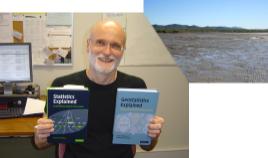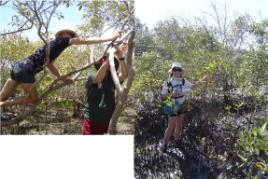Mangrove swamp specialist now proud author of two worldwide textbooks
Published on 20 May, 2010
When Rockhampton-based mangrove swamp specialist Dr Steve McKillup made a few off-the-cuff comments at a book display around five years ago, little did he realise they would lead to publication of two textbooks aimed at students and researchers throughout the world.
Serendipity kicked in when Steve and his wife Ruth, also a scientist, decided to skip a long session on fly identification during a fly specialists' conference in Brisbane.

Dr Steve McKillup with his textbooks. Also pictured are the mudflats of Keppel Sands
They were visiting the conference to meet a Danish scientist who they had corresponded with after finding the world's first fly species known to attack and kill marine snails.
"There was a display of books from Cambridge University Press in the foyer and we made some fairly pithy remarks about a big biostatistics book," Steve said.
"The person in charge of the display, who turned out to be a commissioning editor, said ‘We're looking for an introductory biostatistics text. Could you write one?'
"Before I could say anything Ruth said ‘Steve teaches biostatistics at CQUni and his course is fabulous. And he's won teaching awards'. At the end of the conference the editor invited me to submit a book proposal."
To Steve's surprise - because he took an unusual approach - the book was commissioned. His mangrove research at Keppel Sands took a back seat while Statistics Explained: an introductory guide for life scientists was written.
"I was even more surprised when it started being used for courses in universities in the USA, India, UK, Europe, South Africa and Ireland. Then researchers started using it. I got emails of thanks from all over the world.

Steve taking his research to new heights and (right) wife Ruth in the mangroves
"A year later I was told it was going to be translated into Korean. Students liked the explanations which used simple diagrams instead of complicated mathematics to explain complex statistical ideas. It's an unusual book and it even has a chapter on ethical behaviour (and plagiarism) - which scientists must be aware of."
In 2008, Steve was asked by Cambridge to write a similar book for the geosciences. He then started a long process to identify a geologist to be co-author before teaming up with an American mineralogist.
All the collaboration was done by email.
"A lot of things, including research at Keppel Sands, holidays and essential home maintenance, had to be postponed in 2009 but Geostatistics Explained: an introductory guide for earth scientists has just been published by Cambridge University Press - the oldest publisher and printer in the world, having been operating continuously since 1584.
"The publisher recently signed me up for a second edition of the 'biology stats' book because it's selling so well. I never thought I could write an international textbook and it's made me realise we shouldn't underestimate ourselves at CQUniversity. It's time to accept we can be up there with the well-known international universities, which is where we're heading."
Now the second book is finished, the McKillups are looking forward to doing more research at Keppel Sands. It's been their favourite research haunt for years; even before they made a name for themselves by finding the snail-killing fly* that was new to science.
[* A female fly drops a maggot near each snail. The maggot crawls into the shell and starts chewing away on the snail's body. Even though the snail squirts out lots of thick sticky mucus, the maggot just keeps chewing and the snail dies within an hour. The maggot feeds on the dead snail and a new fly develops inside the shell.]

